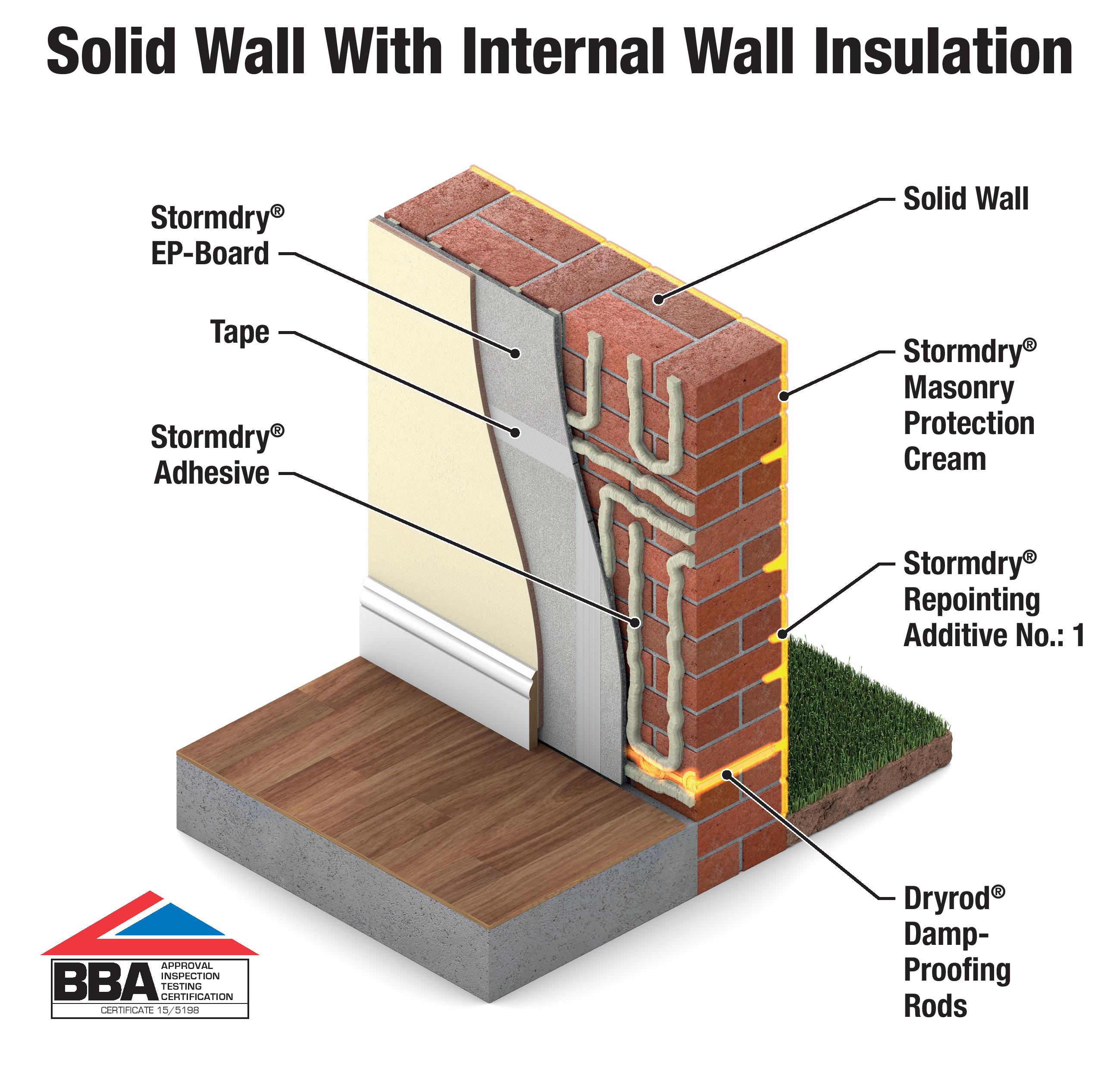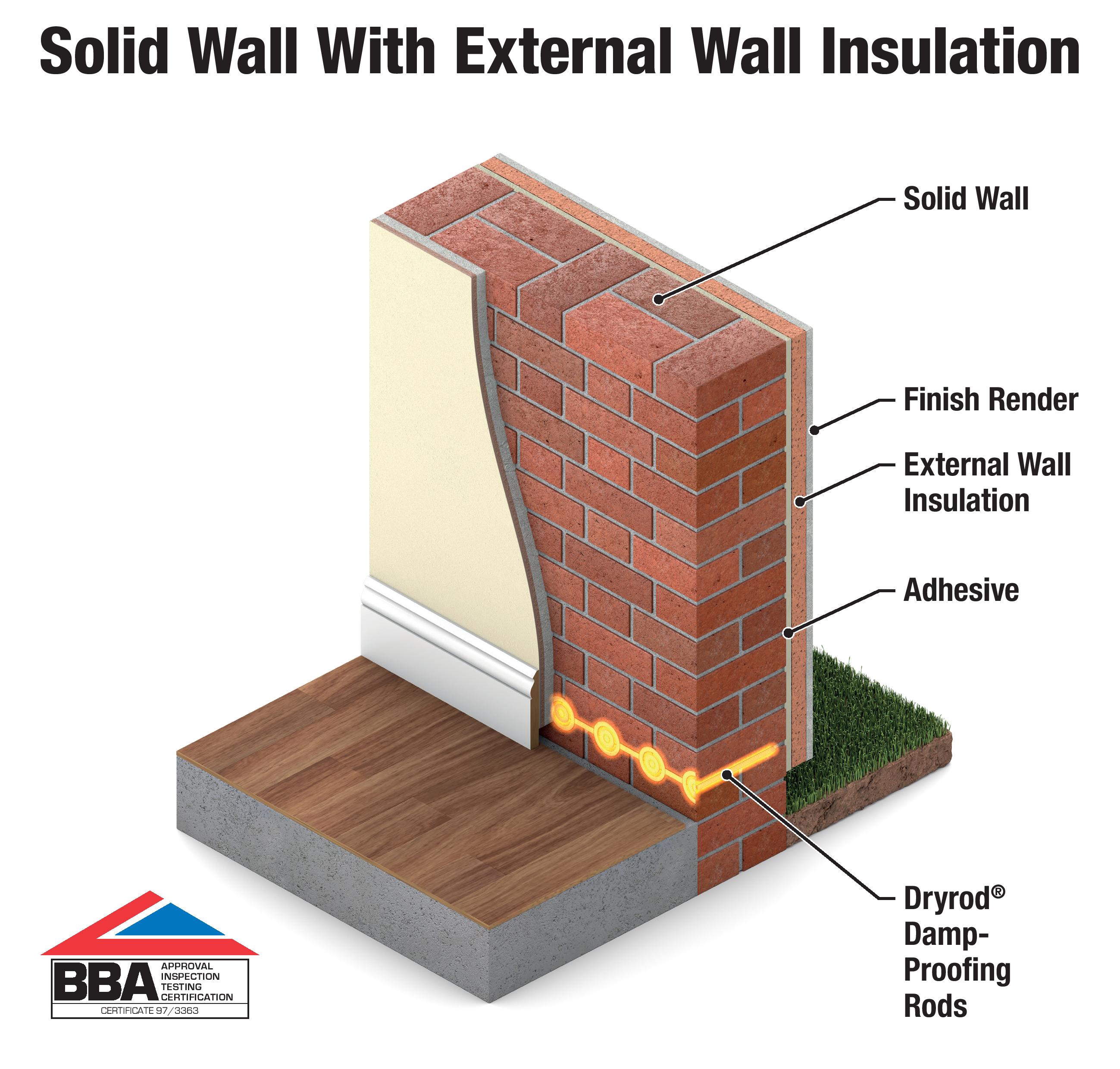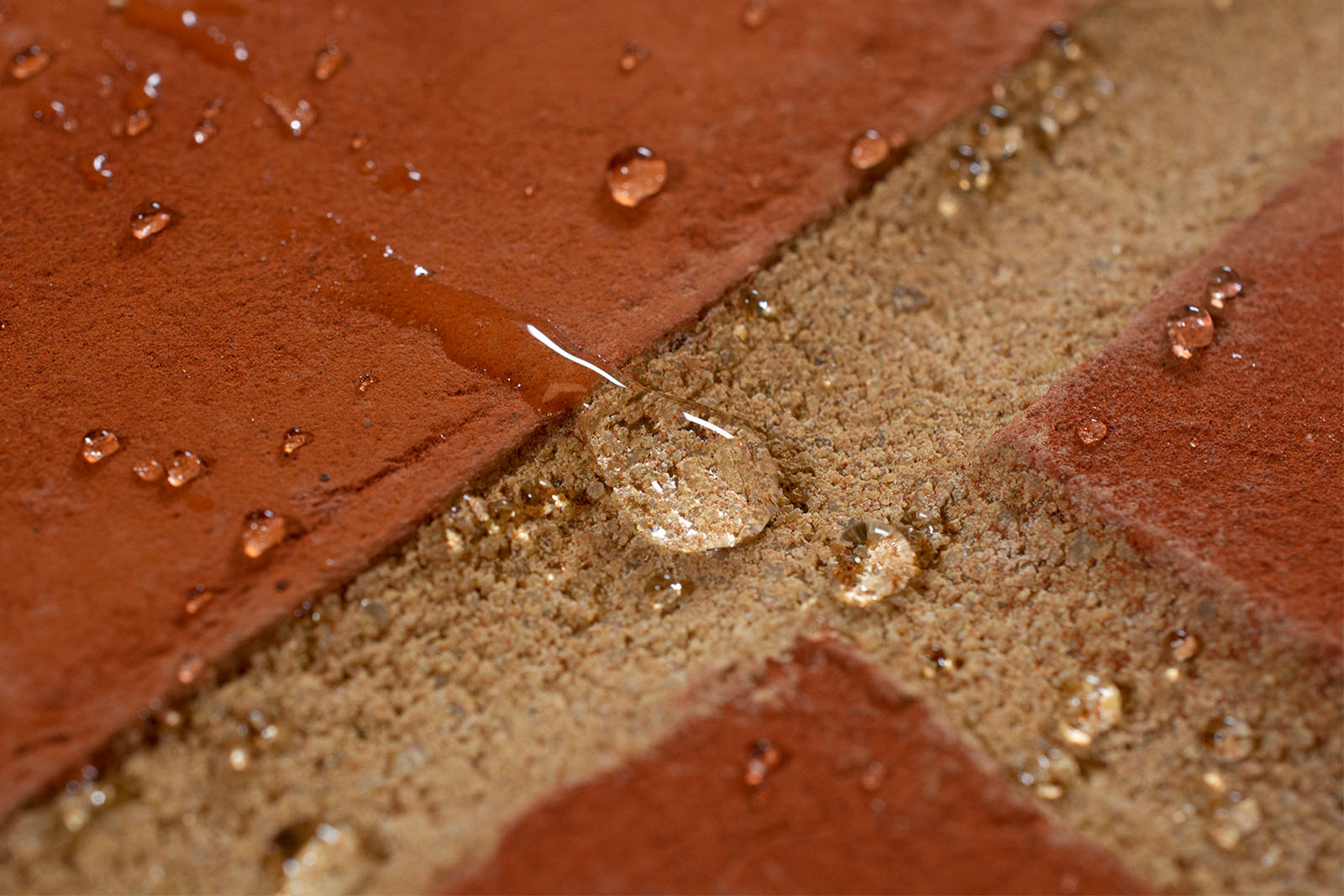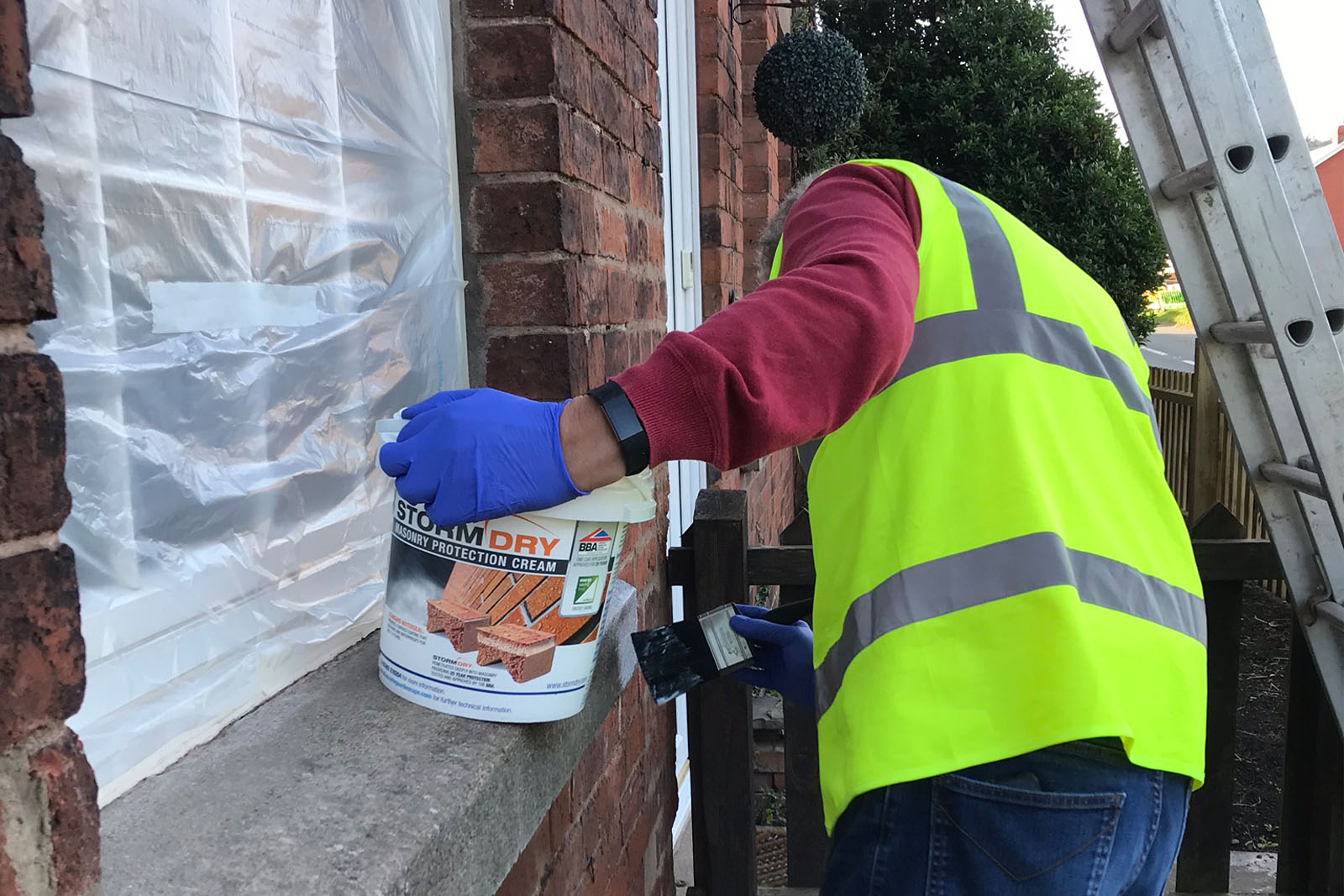Internal solid wall insulation and Stormdry Masonry Protection Cream

Around 8.5 million homes are built with solid wall construction. In statistics ending December 2018, only 752,000 properties had solid wall insulation. In the United Kingdom, these types of houses tend to be older housing stock. Brick solid wall construction housing has been prevalent since the 1600s. It has fallen out of favour over the last hundred years due to the damp-busting benefits of cavity wall construction. Whether your solid wall dwelling is a post-war Addison home or a Palladian masterpiece, it must be retrofitted to retain heat to the modern standard. Solid wall insulation is especially important for those in exposed, wet and windy areas.
If you’re unsure about the type of wall in your home, look at the brick pattern. Solid brick walls tend to space full bricks between half bricks. If this is the case in your home, chances are it is solid wall construction. If all the bricks in your property are full-sized (and your home was built post-1930), chances are your home has cavity walls.
There are many benefits to retrofitting your home with energy-efficiency measures. Having a thermally efficient home retains energy, saves on bills and keeps you warm, dry and safe during the colder months. In short, energy-efficiency measures help insulate your home so that the warmth generated through heating systems cannot escape. Part of this process involves securing and waterproofing windows, doorways and walls. Windows replacements, upgrades, roofing and masonry repairs may also need to be carried out. These upgrades will also secure possible routes of entry, minimising the chances of pest infestation. But retrofit measures do not stop there.
For the wide variety of solid wall homes, retrofitting the home with energy efficiency measures means insulation. According to the Centre of Sustainable Energy, approximately 50% of all heat lost from a solid wall home escapes through the walls. Solid wall insulation is essential. Despite this need, solid wall insulation is relatively new to the UK. A report from the Government Chief Construction Adviser Peter Hansford found that little solid wall insulation had been installed in the United Kingdom before 2008.


Let’s start with the basics. Solid wall insulation is the process of adding an insulative layer to the internal wall of your home. If you’re looking to upgrade your home with internal wall insulation, there are many options. These include:
- Insulation board (such as Stormdry EP Board)
- Stud walls
- Thermal plaster
Whichever method is right for your property, the result will be the same. Your home will retain heat much more effectively than it used to. But before we consider adding insulative material to the interior of the home, is there anything we can do to enhance the heat retention properties of the brick itself?
Brick

Generally, bricks are composed of a mixture of sand, clay and lime. Brick-makers fire these ingredients in a kiln to form bricks that, although strong, contain millions of tiny pores. Placed under a microscope, the internal structure of brick resembles a sponge. These pores give bricks a breathable quality which means that vapour passes through. Bricks provide a pathway for condensation to leave the home. In walls with a single layer of brick between the interior and exterior, solid wall insulation is very important.
In rainy situations, the thermal retention situation worsens. Portsmouth University carried out research into the relationship between thermal conductivity and brick moisture. They found that wet bricks lose twice as much heat as dry bricks.
The course of action is clear. We must do everything we can to ensure solid brick walls remain as dry as possible. Dry bricks are warm bricks.
Stormdry Masonry Protection Cream is the UK’s original brick cream. It waterproofs brick for 25 years in one coat. On a standard Fletton brick, Stormdry creates a thick barrier against water ingress 12mm deep. Stormdry improves energy efficiency by reducing heat loss.
Getting to grips with U-Values

U-values are the standard used by the construction industry to measure how effective building insulation is. They measure thermal performance. The lower the value, the more heat a property retains. A wet solid brick wall has very high U-values of about 2.79. For every degree difference between the inside and outside of a wall, 2.79 watts of electrical power will escape every square metre.
A mostly dry wall will have a lower (but still high!) U-value of around 2.19. After Stormdry brick cream has been applied (and before any other wall insulation), a dry solid wall will have a U-value of around 1.91. As Stormdry is a waterproofer, that U-value will remain generally consistent for an all-round insulative benefit.
After rainfall, Stormdry-applied walls will dry quicker – adding to its energy-saving perks. Water absorbs heat when it evaporates – cooling down the wet surface. This process is called evaporative cooling, and it is the reason why we sweat. To keep walls well-insulated, evaporative cooling must be reduced. Stormdry reduces evaporative cooling in masonry walls.
Stormdry brick cream should be applied to solid wall properties before the installation of internal wall insulation. Why? Because internal wall insulation comes with its own set of problems.
Preventing interstitial condensation in Internal Wall Insulation (IWI)

Interstitial condensation occurs when the relative humidity rises above the dew point of an environment.
Find out more about the science of condensation
Warm air hits an absorbent surface like insulation and causes moisture to form on the wall. Wet walls are cold walls. Condensation damages and affects the main function of insulation. It also sets the stage for another home health hazard: black mould growth.
To test the benefits of Stormdry in properties retrofitted with Internal Wall Insulation, the Safeguard Europe R&D Laboratory embarked upon an 8-year case study.
Explore the Herefordshire Case Study
This 19th-century brick and stone solid wall house had been retrofitted with internal wall insulation along its west-facing front wall. Safeguard applied Stormdry brick cream along the left side of the front of the house. Scientists placed moisture meters along both sides of the front of the house to measure the difference in moisture absorption.
Properties with higher than 60% relative humidity on the exterior wall risk black mould growth. At Herefordshire, the untreated exterior wall had a relative humidity of around 80-100%. This is a sign of penetrating damp and the perfect breeding ground for black mould growth inside the home. Stormdry Masonry Cream protects brick, which helps to keep solid internal wall insulation dry.
Although Stormdry increases the thermal efficiency of walls, it does not contribute to the risk of condensation. The British Board of Agrément proved that Stormdry is vapour-permeable with extensive testing.
Stormdry success in government research

- Find out more about saving energy with Stormdry
- Find out more about Stormdry certifications and accreditations
The Ministry of Housing, Communities and Local Government used Stormdry to test how brick cream affects homes with internal solid wall insulation. The MHCLG team used the WUFI modelling software to simulate weathering on solid brick walls. They tested how the walls fared with and without Stormdry.
The team input measured results from real-world Stormdry test results. For weather modelling, they used real-world atmospheric conditions in Swansea, Bristol, Manchester and London from October 2015-to 2020. The analysis found that the use of Stormdry Masonry Brick Cream lowers the relative humidity of a solid wall by around 10%. In these cases, Stormdry kept the relative humidity low enough to suppress the chances of condensation and black mould growth.
But MHCLG doesn’t leave anything to chance. They used WUFI to assess if any other factors involved in internal solid wall insulation reduced the conditions that cause condensation and black mould. These included:
- With and without an air gap behind internal insulation
- With and without foil layers on either side and one side of the insulation layer
- A selection of different brick types
- Reduced thickness of insulation material
- The addition of a brick cream like Stormdry
In these situations, the only measure that makes enough of a difference to improve the U-value of modelled solid masonry wall homes is the addition of Stormdry Masonry Cream.
Stormdry improves thermal performance and minimises condensation in solid wall homes
Stormdry Masonry Cream is not intended as a replacement for appropriate insulation measures. It improves the thermal performance of solid wall homes. It safeguards against interstitial condensation and black mould in properties with IWI.
Upgrading your solid wall home with an energy-saving retrofit is also a great way to ensure your home stays within evolving building regulations. New UK building regulations from 15 June 2022 will cover fuel and power as well as ventilation standards, for instance. Energy efficiency adds value to homes, both in energy-savings potential and general worth. A Stormdry-treated insulated solid wall home should be more attractive to potential buyers than without.
